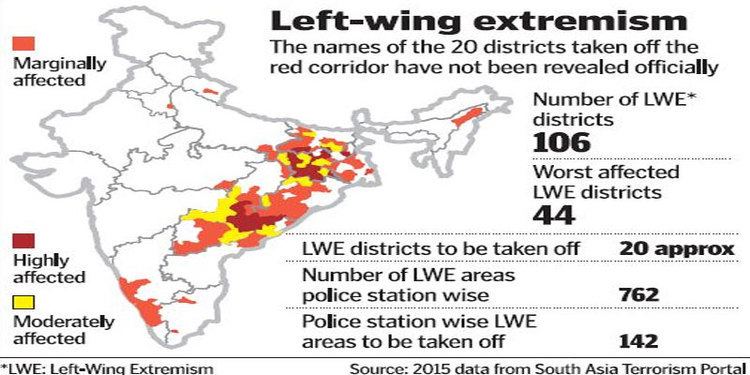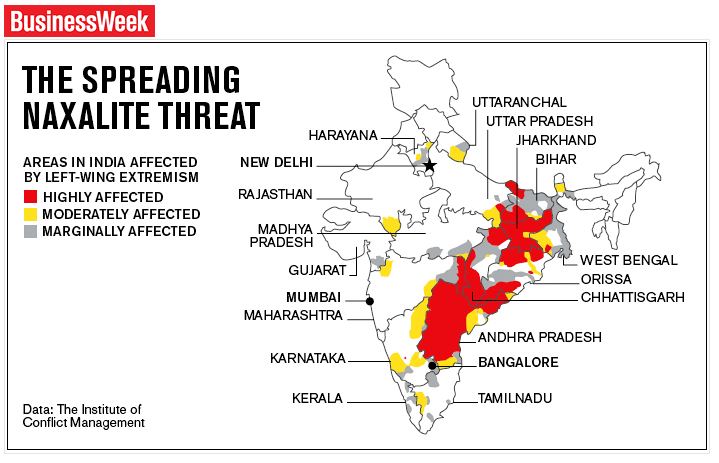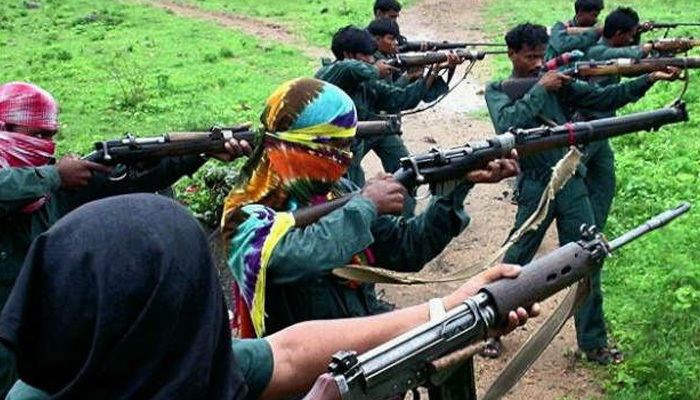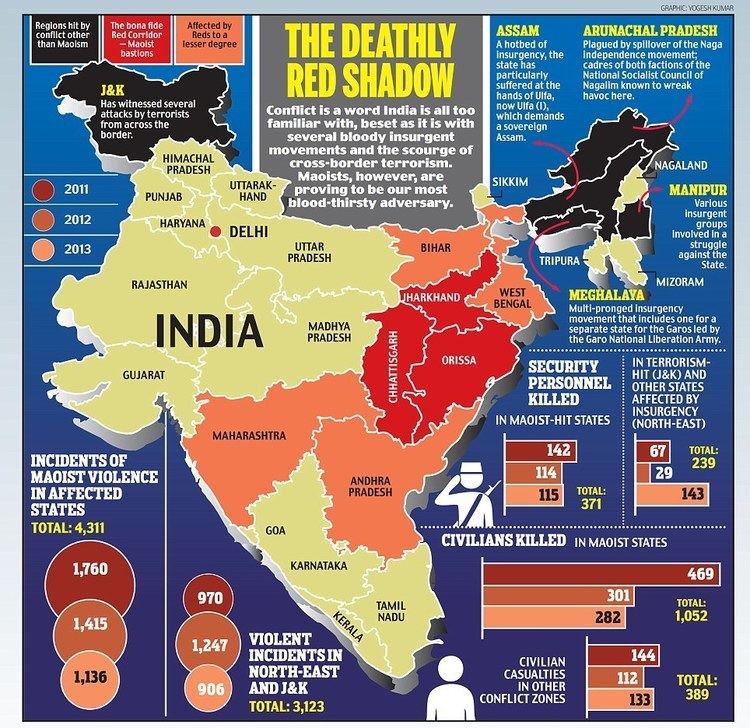Start date 1967 | ||
 | ||
80,000 10,000–20,000 fighters (2009–2010 estimate)10,000–40,000 regular members and 50,000–100,000 militia members (2010 estimate)6,500–9,500 insurgents (2013 estimate) Since 1999 2,672 killed Since 1999 3,253 killed Similar Operation Green Hunt, April 2010 Maoist attack in, Nepalese Civil War, Insurgency in Northeast, Kashmir conflict | ||
The Naxalite–Maoist insurgency is an ongoing conflict between Maoist groups, known as Naxalites or Naxals, and the Indian government. The conflict in its present form began after the 2004 formation of the CPI (Maoist), a rebel group composed of the PWG (People's War Group) and the MCC (Maoist Communist Centre). In January 2005 talks between the Andhra Pradesh state government and the CPI-Maoists broke down and the rebels accused authorities of not addressing their demands for a written truce, release of prisoners and redistribution of land. The ongoing conflict has taken place over a vast territory (around half of India's 29 states) with hundreds of people being killed annually in clashes between the CPI-Maoists and the government every year since 2005.
Contents
- Naxalite
- Region affected
- Public Statements on the Insurgency
- 2002
- 2003
- 2004
- 2005
- 2006
- 2007
- 2008
- 2009
- 2010
- 2011
- 2012
- 2013
- 2014
- 2015
- Human toll
- Deaths related to violence
- References

The armed wing of the Naxalite–Maoists is called the PLGA (Peoples Liberation Guerrilla Army) and is estimated to have between 6,500 and 9,500 cadres, mostly armed with small arms.

The Naxalites control territory throughout Bihar, Jharkhand and Andhra Pradesh states and claim to be supported by the poorest of the rural population, especially the Adivasis. The Naxalites have frequently targeted tribal, police and government workers in what they say is a fight for improved land rights and more jobs for neglected agricultural labourers and the poor. The Naxalites claim that they are following a strategy of rural rebellion similar to a protracted people's war against the government.

In February 2009, the Indian central government announced a new nationwide initiative, to be called the "Integrated Action Plan" (IAP) for broad, co-ordinated operations aimed at dealing with the Naxalite problem in all affected states, namely (Karnataka, Chhattisgarh, Odisha, Andhra Pradesh, Maharashtra, Jharkhand, Bihar, Uttar Pradesh, and West Bengal). This plan included funding for grass-roots economic development projects in Naxalite-affected areas, as well as increased special police funding for better containment and reduction of Naxalite influence. In August 2010, after the first full year of implementation of the national IAP program, Karnataka was removed from the list of Naxal-affected states. In July 2011, the number of Naxal-affected areas was reduced to (figure includes proposed addition of 20 districts) 83 districts across nine states. In December 2011, the national government reported that the number of Naxalite related deaths and injuries nationwide had gone down by nearly 50% from 2010 levels.

The Naxalite–Maoist insurgency gained international media attention after the 2013 Naxal attack in Darbha valley resulted in the deaths of around 24 Indian National Congress leaders including the former state minister Mahendra Karma and the Chhattisgarh Congress chief Nand Kumar Patel.
Naxalite
Naxalites are a group of far-left radical communists, supportive of Maoist political sentiment and ideology. Their origin can be traced to the splitting in 1967 of the Communist Party of India (Marxist), leading to the formation of the Communist Party of India (Marxist–Leninist). Initially the movement had its centre in West Bengal. In recent years, it has spread into less developed areas of rural central and eastern India, such as Chhattisgarh and Andhra Pradesh through the activities of underground groups like the Communist Party of India (Maoist).
In 2007, it was estimated that Naxalites were active across "half of the India's 28 states" who account for about 40 percent of India's geographical area an area known as the "Red Corridor", where, according to estimates, they controlled 92,000 square kilometers. In 2009, Naxalites were active across approximately 180 districts in ten states of India In August 2010, Karnataka was removed from the list of Naxal-affected states In July 2011, the number of Naxal-affected areas was reduced to (including proposed addition of 20 districts) 83 districts across nine states.
Region affected
The Naxalites operate in 60 districts in India, mainly in the states of Odisha (5 affected districts), Jharkhand (14 affected districts), Bihar (5 affected districts), Andhra Pradesh, Chhattisgarh (ten affected districts), Madhya Pradesh (8 affected districts), Maharashtra (2 affected districts) and West Bengal (8 affected district). In West Bengal areas west of Howrah are affected by the insurgency. Chhattisgarh is the epicentre of the conflict (2007).
Areas governed by the elected Communist Party of India (Marxist) in India such as West Bengal, specifically those of Jangalmahal and Lalgarh, are some of the worst affected by anti-state violence by Maoist groups who cite the accumulation of unaccounted for wealth in the hands of CPI-M leaders and specific failure to counter problems they were elected to address such as caste discrimination and poverty.
There is a correlation between areas with extensive coal resources and impact of the insurgency. Naxalites conduct detailed socio-economic surveys before starting operations in a target area. It is claimed that the insurgents extort 14 billion Indian rupees (more than $US300 million).
In Chhattisgarh, Salwa Judum, an anti-insurgency operation, which was aimed at countering the naxalite violence in the region was launched in 2005. The militia consisting of local tribal youth received support and training from the Chhattisgarh state government. An allegation rejected by the state was constituted in response to Naxalite activities, and has come under fire from pro-Maoist activist groups for "atrocities and abuse against women", employing child soldiers, and looting and destruction of property. These allegations were rejected by a fact finding commission of the National Human Rights Commission of India (NHRC), appointed by the Supreme Court of India, who determined that the Salwa Judum was a spontaneous reaction by tribals against Maoist atrocities perpetrated against them.
In Bihar, the Ranvir Sena, a caste-supremacist paramilitary of the upper-caste landlords and proscribed terrorist organisation by the Indian government, has been known to kill Dalit civilians in retaliation for Naxalite activity.
In Odisha, the number of districts affected by Maoist activities has been reduced from 17 to 9, as claimed by the Director General of Police (DGP), Prakash Mishra on December 30, 2012.
Similar paramilitary groups have emerged in Andhra Pradesh during the last decade. Some of these groups are Fear Vikas, Green Tigers, Nalladandu, Red Tigers, Tirumala Tigers, Palnadu Tigers, Kakatiya Cobras, Narsa Cobras, Nallamalla Nallatrachu (Cobras) and Kranthi Sena. Civil liberties activists were murdered by the Nayeem gang in 1998 and 2000. On 24 August 2005, members of the Narsi Cobras killed an individual rights activist and schoolteacher in Mahbubnagar district.
Public Statements on the Insurgency
In 2006, Prime Minister Manmohan Singh called the Naxalites the "single biggest internal security challenge ever faced by our country". In June 2011, he said, "Development is the master remedy to win over people", adding that the government was "strengthening the development work in the 60 Maoist-affected districts.
In 2010 the Indian government's Home Secretary, Gopal Krishna Pillai, acknowledged that there are legitimate grievances regarding local people's access to forest land and produce and the distribution of benefits from mining and hydro power developments, but claims that the Naxalites' long-term goal is to establish an Indian Marxist state. He said the government decided to tackle the Naxalites head-on, and take back much of the lost areas.
In 2011, Indian police accused the Chinese government of providing sanctuary to the movement's leaders, and accused Pakistani ISI of providing financial support.
2002
The People's War Group (PWG) intensified its attacks against politicians, police officers, and land and business owners in response to a July ban imposed on the group by the Andhra Pradesh government. The government responded by tightening security, allegedly ordering attacks on suspected PWG members by state police and the "Green Tigers". Police forces continued to have virtual impunity for the killing of PWG rebels during police encounters. The Maoist Communist Center rebels intensified their armed campaign against Indian security forces following the killing of their leader by police in December. An estimated 140 people were killed in fighting between the PWG and government forces throughout the year. According to government reports, 482 people have died during the conflict that year.
2003
The conflict in Andhra Pradesh intensified as Naxalite rebel groups, in particular the PWG, continued guerrilla attacks on police and government targets while the security forces stepped up counter-insurgency efforts. An October assassination attempt on Chief Minister N. Chandrababu Naidu was consistent with the PWG’s practice of targeting government officials to draw attention to their cause. According to independent media reports, as many as 500 people were killed in the conflict this year, half of these Maoist rebels.
2004
Sporadic, low-intensity fighting between the PWG and government forces continued for most of the year. Attacks on police and TDP party officials, believed to be carried out by the PWG, accounted for most major incidents and deaths. A three-month cease-fire, announced in late June, led to failed negotiations between the government and the PWG. A few days into the cease-fire, an attack attributed to the PWG placed the cease-fire in jeopardy. More than 500 people were killed in sporadic, low-intensity fighting, a reduction from previous years. Most victims were members of the police forces or the Telugu Desam Party (a regional political party).
2005
Violent clashes between Maoist rebels and state security forces and paramilitary groups increased following the breakdown of peace talks between the PWG and the state government of Andhra Pradesh. Rebels continued to employ a wide range of low-intensity guerrilla tactics against government institutions, officials, security forces and paramilitary groups. For the first time in recent years, Maoist rebels launched two large scale attacks against urban government targets. Fighting was reported in 12 states covering most of south, central and north India with the exception of India’s northeast and northwest. More than 700 people were reported killed this year in violent clashes. Over one-third of those killed were civilians.
2006
Maoist attacks continued, primarily on government and police targets. Civilians were also affected in landmine attacks affecting railway cars and truck convoys. Clashes between state police and rebels also resulted in deaths of members of both parties, and civilians that were caught in the firing. Fighting differs from state to state, depending on security and police force responses. In the state of Andhra Pradesh, security forces have been somewhat successful in maintaining control and combating Maoist rebels. The other state that is most affected, Chhattisgarh, has seen an increase in violence between Maoist rebels and villagers who are supported by the government. In 2006, 500 to 750 people were estimated killed, fewer than half Naxalites, and approximately one-third civilians.
2007
Fighting continued between Naxalite Maoists and government security forces throughout the year. The majority of hostilities took place in Chhattisgarh, which turned especially deadly when over 400 Naxalites attacked a Chhattisgarh police station, seizing arms and killing dozens.
In November 2007 reports emerged that anti-SEZ (Special Economic Zone) movements such as the Bhoomi Uchched Pratirodh Committee in Nandigram in West Bengal, which arose after the land appropriation and human displacement following the SEZ Act of 2005, have joined forces with the Naxalites since February to keep the police out. Recently, police found weapons belonging to Maoists near Nandigram. Civilians were forced to choose between joining the Maoist insurgence or supporting the Salwa Judum and face coercion from both sides. According to news reports, this conflict resulted in 650 deaths during 2007; of these 240 were civilians, 218 security personnel and 192 militants.
2008
Civilians were most affected in the ongoing fighting between Maoist rebels and government security forces. Of the 16 states touched by this conflict, Chhattisgarh and Jharkhand were the most affected. One positive note for Chhattisgarh was that fatalities, although still high, were significantly down from 2007. Similarly, Andhra Pradesh, the state with the most Maoist activity a few years ago, has improved security with a corresponding drop in fatality rates. Unfortunately, as conditions have improved in Chhattisgarh and Andhra Pradesh, the Maoist forces seem to have shifted their operations to the state of Orissa where conditions have worsened. South Asia Terrorism Portal’s fatality count across the six states that saw the majority of the fighting (Bihar, Orissa, Jharkhand, Maharashira, Chhattisgarh, and Andhra Pradesh) was 794. This included 399 civilians, 221 security force personnel and 174 insurgents.
2009
In 2009, Naxalites were active across approximately 180 districts in ten states of India.
In September 2009 India's Prime Minister Manmohan Singh admitted that the Maoists had growing appeal among a large section of Indian society, including tribal communities, the rural poor as well as sections of the intelligentsia and the youth. He added that "Dealing with left-wing extremism requires a nuanced strategy – a holistic approach. It cannot be treated simply as a law and order problem." In the first half of 2009, 56 Maoist attacks were reported. The South Asia Terrorism Portal reported 998 killed in the conflict: 392 civilians, 312 security forces and 294 rebels.
2010
During February the Silda camp attack killed 24 paramilitary personnel of the Eastern Frontier Rifles in an operation the guerillas stated was the beginning of "Operation Peace Hunt", the Maoist answer to the government "Operation Green Hunt" that was recently launched against them. According to Crisis Watch and various news sources, between 500 and 600 people were killed this year. Of those killed, approximately 366 were civilians, 188 were government troops (including police) and 27 were Naxalites. According to South Asia Terrorism Portal and government sources, over 1,000 deaths occurred in the conflict this year. This includes 277 security forces, 277 Naxalites, and more than 600 civilian.
On 6 April, Naxalite rebels killed 76, consisting of 74 paramilitary personnel of the CRPF and two policemen. Fifty others were wounded in the series of attacks on security convoys in Dantewada district in the central Indian state of Chhattisgarh. The attack resulted in the biggest loss of life security forces have suffered since launching a large-scale offensive against the rebels. On 17 May, a Naxalite landmine destroyed a bus in Dantewada district, killing up to 44 people including several Special Police Officers (SPOs) and civilians.
On 28 May the derailment of a Kolkata–Mumbai night train killed at least 150 persons. Police alleged that Maoists had caused the derailment by removing a short (46 cm or 1½ft) piece of track, but the Maoists denied this.
On 29 June, at least 26 policemen are killed in a Maoist attack in the central Indian state of Chhattisgarh.
On 29 August, a joint team of BSF and district police was attacked by the rebels in Bhuski village (Chhattisgarh) under Durg Kondal police station in the district while they were conducting routine search operations in the wee hours. Following the attack, the forces retaliated and in the action they lost five security personnel, including three BSF jawans.
On 29 and 30 August, rebels ambushed a joint paramilitary-police team in Bihar, killing 10, wounding 10 more, taking 4 prisoners and robbing more than 35 automatic rifles from the state forces. The Naxalites later freed 3 of the policemen after Naxal leader Kishenji met with worried family members.
On 12 September, Naxalites killed 3 policemen and took 4 more hostage in an ambush in Chhattisgarh. The 4 policemen were later released without conditions after Naxal leaders listened to the appeals of family members. The freed policemen also promised the Naxals to never take up arms against the insurgency again.
On 5 October, rebels killed 4 Police officers as they were on their way to a market in Maharashtra.
On 7 October, Naxalites attempted derailment of Triveni express, a train of Singrauli-Bareilly route, by removing 4 fishplates and 42 sleeper clips.
On 8 October, Naxalites triggered a landmine in the border area between Chhattisgarh and Maharashtra. The attack killed 3 Indo-Tibetan Border Police (ITBP) jawans, wounded 2 more and destroyed a military jeep.
2011
During May, Naxalites killed and dismembered ten policemen, including one senior officer in the Gariyaband, Chhattisgarh area on the border with Orissa. In June, the total fatalities of both the police and the paramilitary was 43.
On 21 July 2011, Maoist rebels in the central Indian state of Chhattisgarh blew up a bridge, killing four people and wounding five others. The attack happened when the Congress party chief of the state, Nandkumar Patel, was returning from a party function.
Despite the continued violence in 2011, the most recent central government campaign to contain and reduce the militant Naxalite presence appears to be having some success, the 2011 toll of 447 civilians and 142 security personnel killed having been nearly 50% lower than the 2010 toll. Some states experiencing this sharp reduction in Naxalite hostilities, such as Madhya Pradesh, attribute their success to their use of IAP funds for rural development.
2012
In mid-March, Maoist rebels kidnapped two Italians in Orissa. They later released one, while the government of Orissa negotiated for the release of the second. The Maoists released the second hostage in the middle of April. The Member of the Legislative Assembly(MLA) of Laxmipur constituency (Orissa), Jhin Hikka, was abducted by the Maoists in March, who demand the release of 30 Maoist cadres (presently in jail) in exchange for the freedom of the MLA. The Orissa Government is negotiating with the cadres with the help of arbitrators to free the MLA.
On 27 March, an explosion blamed on Maoists killed 15 Indian policemen in Maharashtra.
2013
The 2013 Naxal attack in Darbha valley resulted in the deaths of around 24 Indian National Congress leaders including the former state minister Mahendra Karma and the Chhattisgarh Congress chief Nand Kumar Patel.
2014
2015
Human toll
The first combat deaths of the insurgency were in 1980. Around 1,100 people are known to have died during 2009. The number includes 600 civilians, 300 security personnel and 200 rebels.
There were more than 40,000 displaced people in 2006.
According to the Institute of Peace and Conflict studies, Naxal groups have recruited children in different capacities and exposed them to injury and death. However the same accusation has been levelled at the state-sponsored Salwa Judum anti-Maoist group, and Special Police officers (SPOs) assisting the government security forces. Seven personnel of Special Task Force (STF) were killed and eleven others injured in an encounter with outlawed Communist Party of India (Maoist) rebels at a village near Chhattisgarh's Bastar region on Saturday.
Additional director general of police (anti-Naxal operations) Rajinder Kuamr Vij said that the encounter took place at Pidmal village between Dornapal and Chintagufa when the rebels tried to attack the security personnel. The forces retaliated leading to a fierce encounter during which seven security personnel died and eleven others injured. The team of 49 STF men which ventured into the Maoists’ “liberated zone” on Saturday morning, had reportedly not informed senior police officers based in Bastar and Sukma before embarking on an operation which eventually proved “suicidal.” Seven personnel, including the Platoon Commander, Shankara Rao, were gunned down by the Maoists.
Deaths related to violence
According to the BBC, more than 6,000 people have died during the rebels' 20-year fight between 1990 and 2010. Al Jazeera put the death toll at more than 10,000 between 1980 and 2011.
Based on the above displayed statistics, it can be determined that more than 13,000 people have been killed since the start of the insurgency in 1980, most of them in the period since 1996.
